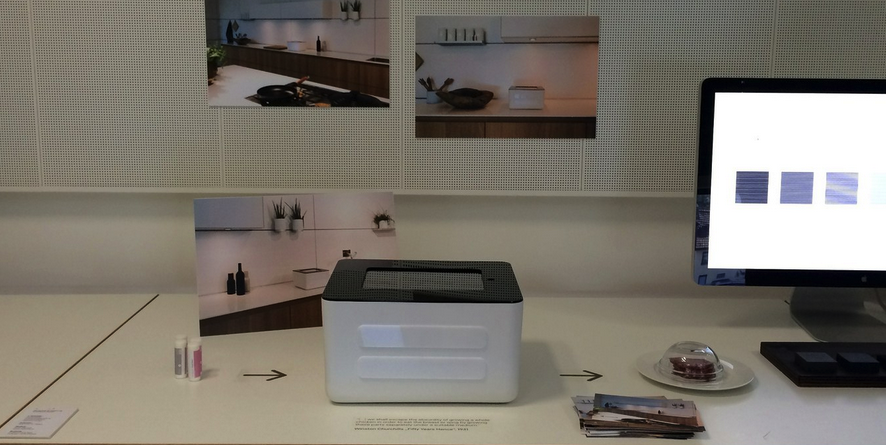It was 1931 when Winston Churchill was quoted in an essay he wrote for Strand Magazine saying, “We shall escape the absurdity of growing a whole chicken in order to eat the breast or wing, by growing these parts separately under a suitable medium.”
Here we are some 84 years later and his vision is rapidly approaching reality, through advancements in several technologies which were unimaginable during his lifetime.
Lab grown meat, or better yet, 3D printed meat will be a reality eventually. The only questions are, “When will such technology be available,” “Will people embrace it,” and “How will the technology actually work?” Well, a team of two  German students, Sarah Mautsch and Aaron Abentheuer, from the University of Applied Sciences Schwäbisch Gmünd, have teamed up to create an open source conceptual prototype of a machine they say could one day print a variety of meats, and fit into a kitchen no differently than a microwave oven.
German students, Sarah Mautsch and Aaron Abentheuer, from the University of Applied Sciences Schwäbisch Gmünd, have teamed up to create an open source conceptual prototype of a machine they say could one day print a variety of meats, and fit into a kitchen no differently than a microwave oven.
Named the Cultivator, their creation is a concept which takes into account the changing design and atmosphere of a typical kitchen you’d likely find in the near future. The device is conceptualized as a sleek white box, with a black iPad-like surface at top. They chose the color black to mimic the common kitchen cooktop color we are already familiar with. In order to show off their concept, they had to make a semi-functioning device (no it does’t print meat…yet) that would attract the attention of those in attendance at a recent exhibition at the school.
The hardware was created with thermoformed polystyrene, which they then placed a laser cut sheet of black acrylic glass and an iPad on top to act as both a mock cooktop as well as functioning user interface. The software was developed using the iOS platform, and functions on the iPad, allowing the would-be user to select their custom profile while also selecting different types of meat to print. Each type of meat selection provides the user with the nutritional content along with the ability to customize the composition to suit one’s own  health requirements. Lacking a certain mineral lately? Just have the printer add it to the 3D printed meat.
health requirements. Lacking a certain mineral lately? Just have the printer add it to the 3D printed meat.
“The Interface of cultivator contains a collection of recipes,” explains Mautsch on her blog. “The recipes are made of organizations like the cultivator itself, popular cooks or families and friends. Recipes describe the meat through three different parameters, color, juiciness and structure. The different minerals result from these parameters. and can not be justified by the user individually; but there is a function that allows the user to adjusts minerals (and parameters) according to his health info.”
They envision the actual printer will run mainly off of solar power, fueled by the light that’s present in one’s kitchen. While no date is given as to when they see such a device actually making its way into people’s homes, the fact that they’ve open sourced their concept could just provide enough fuel for either a startup or even an established tech company to further develop and eventually bring such a device to market. Of course we are years away from such technology being available, as well as affordable for the typical middle class family, but it’s concepts and ideas like these which will eventually lead the way to a brighter future for us all.
Let’s hear your thoughts on this rather interesting meat printer concept in the Cultivator Meat Printer forum thread on 3DPB.com. Check out the video clip below introducing this concept in further details, and feel free to download the open source files here.
Subscribe to Our Email Newsletter
Stay up-to-date on all the latest news from the 3D printing industry and receive information and offers from third party vendors.
You May Also Like
Gorilla Sports GE’s First 3D Printed Titanium Cast
How do you help a gorilla with a broken arm? Sounds like the start of a bad joke a zookeeper might tell, but it’s an actual dilemma recently faced by...
Nylon 3D Printed Parts Made More Functional with Coatings & Colors
Parts 3D printed from polyamide (PA, Nylon) 12 using powder bed fusion (PBF) are a mainstay in the additive manufacturing (AM) industry. While post-finishing processes have improved the porosity of...
$25M to Back Sintavia’s Largest Expansion of Metal 3D Printing Capacity Since 2019
Sintavia, the digital manufacturing company specializing in mission-critical parts for strategic sectors, announced a $25 million investment to increase its production capacity, the largest expansion to its operations since 2019....
Velo3D Initiates Public Offering in a Bid to Strengthen Financial Foundations and Drive Future Growth
Velo3D (NYSE: VLD) has been among a number of publicly traded 3D printing firms that have attempted to weather the current macroeconomic climate. After posting a challenging financial report for 2023,...
































